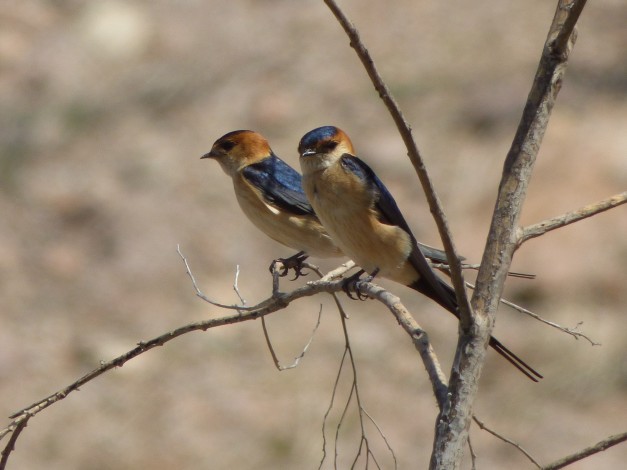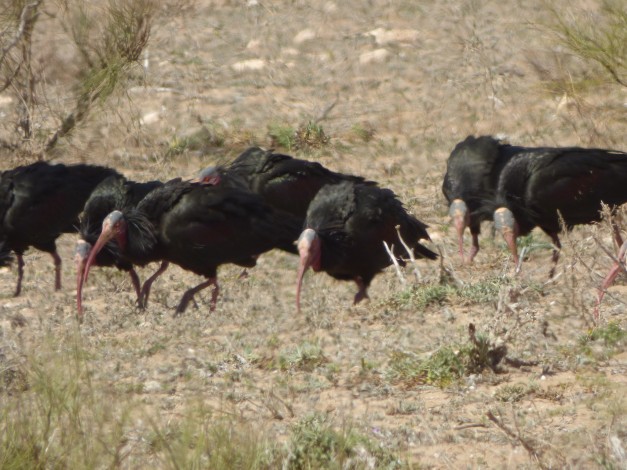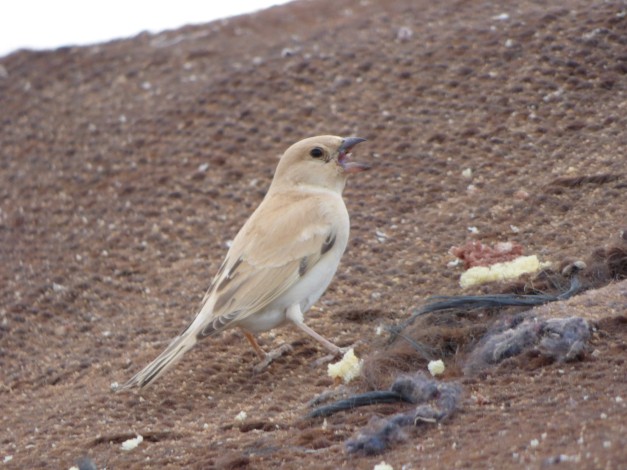Morocco Birding Tour 2019 Trip Report
Starting Date: 14th March, 2019
Number of participants: 5
Day 1. After arriving to Marrakech from different countries, the tour participants to explore Morocco in 2019 assembled in one hotel in town. Next morning, we had an early breakfast and left the accommodation in a bright morning. While getting in the van, we got the firsts birds of the trip: Eurasian Blackbirds, some House Buntings and several Pallid Swifts flying over.
The day was sunny and calm. High temperatures affecting Europe had been also recorded in Morocco, and just one day before we arrived the city scored 32ºC, a mark more likely to happen in mid May than in mid March.
The first area to explore was Imlil valley, South West of Marrakech and already well inside the Atlas. A first stop en route provided us with good views on Lesser Kestrels in a small colony by the road. There were at least 8 of them, flying and chasing each other while callin, and some tour participants had here the firsts African Chaffinch of the trip.
Kept driving for 10 minutes more until we parked to scan some decidious trees. Not even 1 minute after everybody was out the van we already had 1 Levaillant’s Green Woodpecker moving along the line of trees, and offering great views while moving up in a poplar. The view was incredible and everybody enjoyed it but after a pair of minutes we got distracted 2 Atlas Great Spotted Woodpeckers doing its way in the trees. This is endemic race, a also a canditate for a future Split from the European forms. 1 African Blue Tit came out to give us great views, just at the same time than the Levaillant’s Green Woodpecker flew in for a closer view, perching low in poplar! The bird sat there for more than 3 minutes allowing everybody to have wonderful views on the bird!

The Woodpecker slowly made its way up the branch while our attention went to 2 Red-rumped Swallows flying over along with some Little Swifts. White Storks were moving around while an Eurasian Wren was singing low in the dense undergrowth. A nice male African Chaffinch was showy in a wire so everybody had excellent views on it. After some more views on the Levaillant’s Green Woodpecker we decided to move on to the next spot.
In our way we just got 2 Barbary Partridges flying around and 2 Short-toed Snake Eagles circling in a nice view. We had a stop in a slope covered by wonderful juniper. After few scanning we just got a pair of Tristam’s Warbler moving low in the junipers but the birds were extremelly restless, most of the time moving really low in the bush so it made difficult to get the bird for most of the tour partipicants. We didn’t give up. We kept scanning around while having ruff views on the birds moving low in the junipers. A pair of Coal Tits was feeding in the junipers, 1 male Sardinian Warbler was a nice adding and we got excellent views on a Rock Bunting singing from the top of one of the highest trees. But the Tristam’s was still not showing well. Everybody in the group was already having brief views on the rusty wings, contrasted with the lovely greyish head, but never long enough to enjoy. We were really about to leave when a wonderful male just came out of the vegetation, showing out in the top of a juniper for some seconds! Time enough for everybody to connect with the bird and have good views on the details!

After such a wonderful views we got back to the minibus and kept going up. When crossing a small pinewood a song came inside the van; North African Treecreeper! We stopped and started scanning around. North African Treecreeper is noticeably different from Short-toed Treecreeper. The North African race (mauretanica) is a serious canditate for a future split based on calls, song and also plomage differences from the European race.
We went out and scan the tree. Soon we were enjoying a wonderful male Firecrest and a bit more to right, we got the North African Treecreeper singing from a branch! It was really great to have the bird singing in the same brach for nearly a minute!! African Chaffinches were also showy but our attention turned to a pair of Eurasian Sparrowhawks displaying up in the sky! 2 Hawfinches were calling in the patch but, despite our efforts, we never connected with them…

Back to the minibus we just drove until Oukaïmeden with small flocks of Red-billed Choughs joining us during the tour. Once in Oukaïmeden a fast scanning around allow us to have good views on Mistle Trush but also in a nice mixed flock of Common Chaffinches and Bramblings. We got really good looks in some male Bramblings in summer plomage while feeding in the grass.
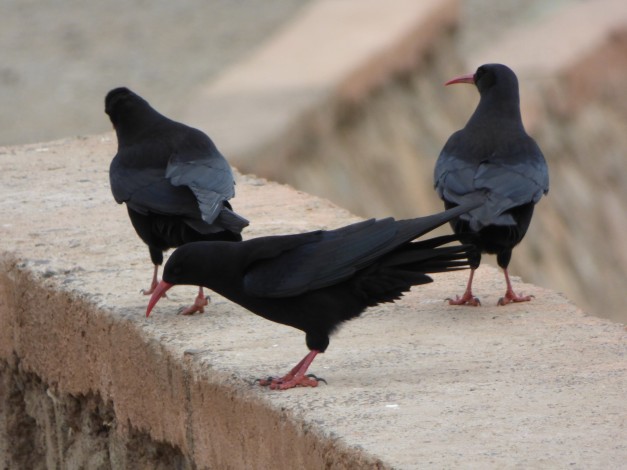
For us was also time to feed so we went into a restaurant and have a good meal. After lunch we kept scanning for some of the good high mountain birds living in the area. Had a pair of short walks with nothing else but obliging Black Redstarts. We walked around a small village expecting to be more lucky. And we did. 1 Little Owl was nicely showing in one of the roofs and 3 Atlas Shore Larks flew around, chasing each other in a really fast sequence. We tried to refind the larks, but was impossible. We were going to try a last attempt in a different corner of the valley when a bird appeared in front of the van: 1 African Crimson-winged Finch! Again went down and got good views on the bird. It flew to the right, just to join two more finches on a corcreek by the track. A fourth bird appeared from some where… We kept enjoying such a scarce bird when they suddenly flew out, flying up in the valley followed by a small flock of Common Rock Sparrows. Few minutes after the finches came back, now reconverted in a flock of 8 and we got really good views on the birds in walk away views.
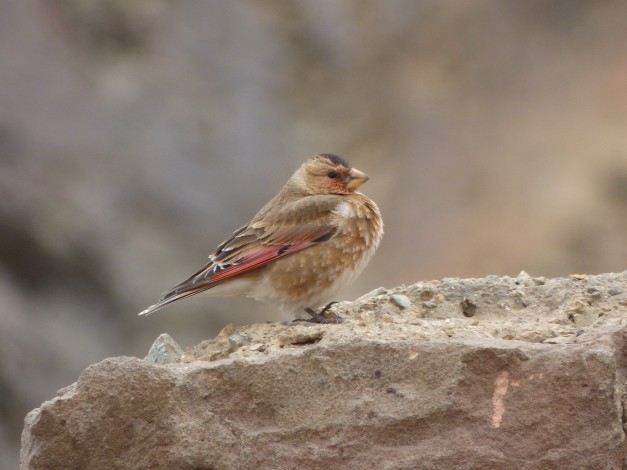
Happy after these nice views we just got back to our accommodation for some rest.
Day 2. We got an early morning start with a transfer of about 3 hours to Agadir. Some road birding allow firsts views on Algerian Shrike but also Crested Larks. Our first stop was near Tamri, the most famous place to try to have Northern Bald Ibis. We parked the van with a light fog fastly disappearing and fastly got nice views on Black-eared Wheatears singing in the bushland. Thekla’s Larks were also active and got nice views on one male Spectacled Warbler. 1 Algerian Shrike was sat up in a bush, allowing nice views while going on with the difficult taxonomy of the group and the slight differences between Algerian & Canary Island Shrike (koenigi). At this moment, a migratory flock og 5 Yellow Wagtails passed above us while calling on its way back to Europe.
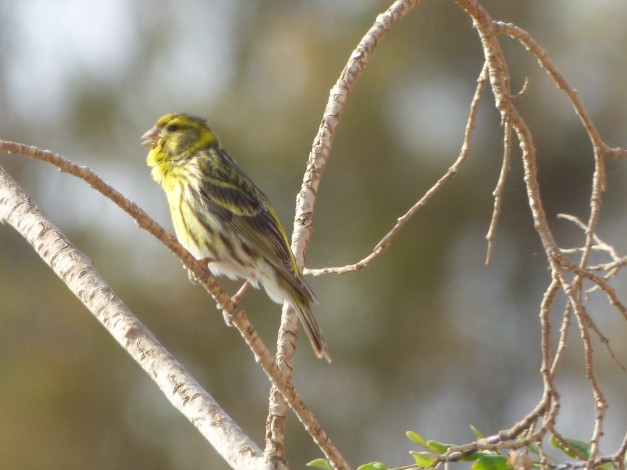
A short walk in the wonderful dunes allow to see a distant flock of Northern Bald Ibis. There were 8 birds feeding on the ground with 3 more small flocks moving here and there in the getation. In the distance, some birds were flying above the cliffs, carrying preys to the nearby colony. We were having nice views on the birds until 1 Long-legged Buzzard appeared in the sky and all ibises flew off. Some of them came our way, allowing excellent views on flight. They flew over us, landing a bit beyond. We just moved 40 metres and then we were having a flock of 9 birds moving on the ground in a wonderful light. The birds were tipically feeding by peeking the ground in a nervous movement to get insects and other invertebrates. The birds kept coming closer and closer and, at the end, we got them only 30 metres away from us!!
Happy after such a wonderful views we just went back to the van and left the area for a good lunch. Our lunch got a bit longer than expected to appear on table but we were joined by lovely views on Red-rumped Swallows and Pallid Swifts. Back in the field we went to Tamri Estuary for some birds. Just arrived we got 2 Moroccan Wagtails flying around, one of them offering good views to all tour participants. A short walk in the beach is necessary to have good views on the estuary. It is also a good place for Kentish Plover and we got good views on a bird in winter plomage. It took some time to put everybody on the bird but we all finally got excellent views. Once closer to the mouth of the river we got good views in a large flock of Lesser Black-backed Gulls joined by 20+ Audouin’s Gulls including adults but also interesting 2nd year plomages. Yellow-legged Gulls were also in low numbers. In the river, 15 Eurasian Coots were feeding and 2 Western Marsh Harriers were flying above the reedbeds. The shore was having some small birds and we were happy to have 2 more Kentish Plovers along 1 Gull-billed Tern and 1 distant Dunlin. 4 Common Ringed Plovers were also resting in the beach, not far from the flock of gulls. Grey Heron and Little Egret were also noted.
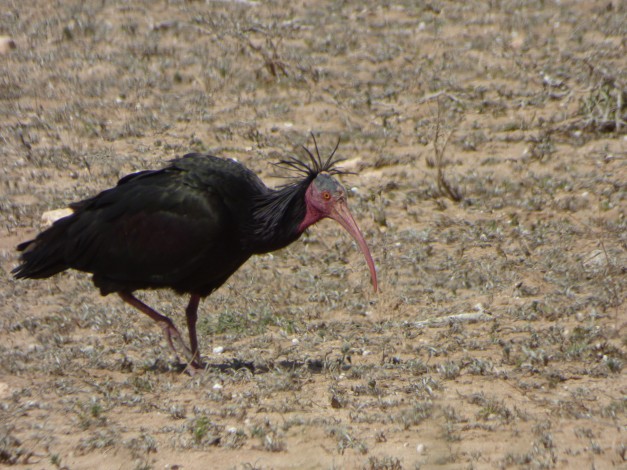
Scanning the area around we got a Sedge Warbler calling in small patch of reeds just in our back. Some scanning was required but we all got good views on the bird, moving along with a Sardinian Warbler. Zitting Cisticola and Cetti’s Warbler were also moving around. In the opposite side of the river, a small flock of Northern Bald Ibis was roosting. A nice way to say good bye to this wonderful corner!
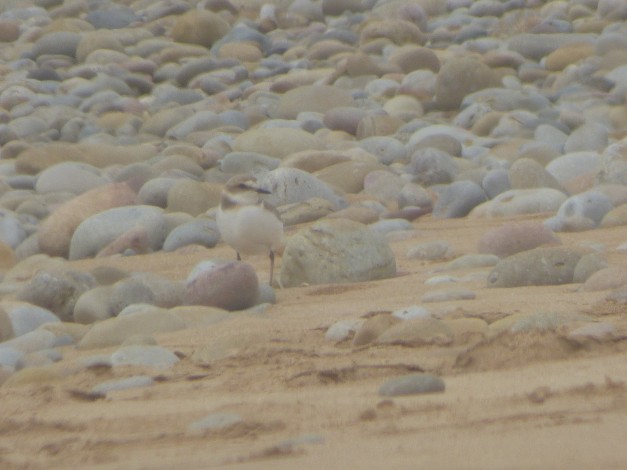
Back in the minibus we drove back to Agadir, where we were going to explore the Estuary of the River Souss, inmediatly South of the town. Driving in the area we had several good views on Maghreb Magpies. Once arrived we spend a good time scanning the shores. There were several Black-headed Gulls, 10+ Medirranean Gulls (mainly juveniles) and two distant Slender-billed Gulls roosting along with Black-headeds and Lesser Black-backes. Up in the river, a distant flock of Greater Flamingoes was a nice adding and, by the flock, we noted the first Black-winged Stilt of the trip.
A closer area of the estuary was having 2 gorgeous Ruddy Shelducks showing really well. Along with them, good numbers of Common Redshanks but also several Greenshanks, Common Sandpipers, Eurasian Curlews, Eurasian Oystercatchers and Grey Plovers. 2 Ruffs were also feeding in the shore and we got 2 Wood Sandpipers flying around the area. A further scanning produced a wonderful Eurasian Spoonbill feeding on the water, approaching us with its typical side-to-side movement. A Western Osprey was aware of all this activity, catching a lot of good afternoon light. The bush around was having some small birds, including Zitting Cisticola, Sardinian Warbler, European Serin and Maghreb Magpies. I was expecting some migratory small birds, but got nothing. Instead we got a nice Eurasian Sparrowhawk perched low in a tree and a favolous flock of 44 Eurasian Spoonbills passing over.
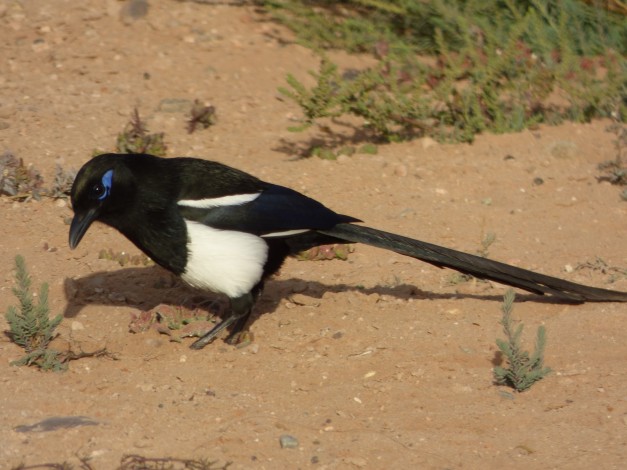
Mallards, Great Cormorants and 1 distant Common Shelduck were noted before going to our accommodation for some rest after a long, but good day!
Day 3. Another sunny day in Morocco. This time we were exploring the Massa River. A number of ponds, marshy areas and reedbeds compose a great birding area in the lower Massa. Ours first stop was to explore was of these ponds. Even before getting out the van we started getting good birds. 2 Eurasian Hoopoes were feeding by the road and a nice flock of Spanish Sparrows was along with them. Some Moussier’s Redstarts were moving in the euphorbias that carpet the slopes around. A fast scan produced Little Egret feeding on the shore along with 2 Eurasian Moorhens. Deep in one tamarisk tree, a female Eurasian Sparrowhawk was overlooking the pond. The riparian vegetation was full of Cetti’s Warblers singing and 1 obliging Sedge Warbler that came out of the vegetation to take a bath right beside some Spanish Terrapins. A short walk around produced the first Common Chiffchaff of the trip as well as African Chaffinches and 1 surprisingly Eurasian Wryneck up in a palm tree. The bird was feeding between the death hanging leaves of the palm tree, joined by Common Bulbuls and Eurasian Blackcaps. Some Laughing Doves were feeding on the ground, but also singing in the trees around. A distant Black-crowned Tchagra was singing in the distance…impossible to reach.
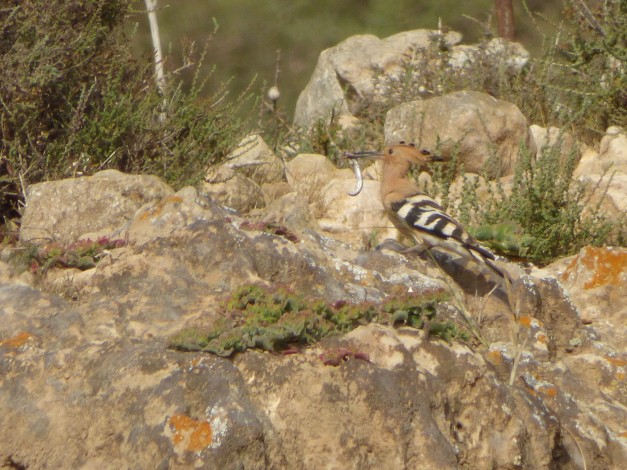
Our second stop was to explore another corner of the Massa River with few reedbeds but good mud product of the low water level. Here we had a flock of 6 Eurasian Teals feeding on the mud, joined by 1 Green Sandpiper, 1 Common Snipe, 1 Common Sandpiper and 6 Little Ringed Plovers displaying and working hard to “fence” their territories. 1 Eurasian Spoonbill was roosting in the area along with 2 Great Cormorants. We kept scanning around and suddenly we had a Black-crowned Tchagra sang in big bush in the left. We all scanned around, being uncapable to find the birds. For instance, we got good views on 1 Willow Warbler moving on the open ground nad 1 male Subalpine Warbler skulking in the bush. Several European Serins were also really active, with close views on some singing males. We moved about down the river to scan a different angle of the bushland and then is one of the tour participants went on locating 1 Black-crowned Tchagra quietly preening in the top of one of the bush! Really a great spot that we could enjoy for long since the bird stayed in that position for above 5 minutes! Excellent views!!
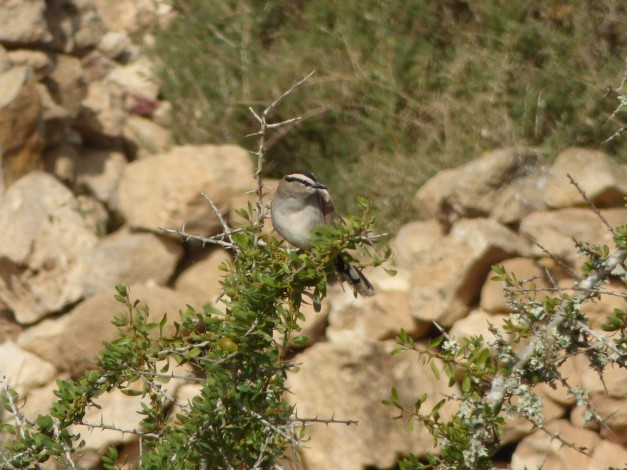
We came back to pond for more scanning. Now, 1 Italian Yellow Wagtail was moving in the mud, providing good views. Then, 1 female Little Bittern just cross the pond, offering views in flight for a few seconds! Always wonderful to enjoy a Little Bittern, even if being short views… Still, the area was not offering anything else so we decided to leave, not without listening a distant Common Nightingale before getting inside the minibus.
Our last stop that morning was to explore one of my favourite corners of the river. We walked along the riverside. African Chaffinches were quite active, singing and feeding around and 2-3 Black-crowned Tchagras were also singing from deep inside the bush. 2 Black-crowned Night Herons were roosting in the rank vegetation, offering good views. 1 Common Kingfisher was also perched in a low branch. Along the shore, 5 Green Sandpipers and 1 Greenshank were also visible along with 1 lovely Squacco Heron. 2 Glossy Ibis passed over, going to one of the main roosting places in the area. We kept walking and scanning around. The small bush around produced really good looks on Common Chiffchaff and Sardinian Warbler but fastly our attention went to 1 Brown-throated Martin flying really low above the water! The bird, moving fast, was followed by up to 3 more birds moving around and allowing great looks!
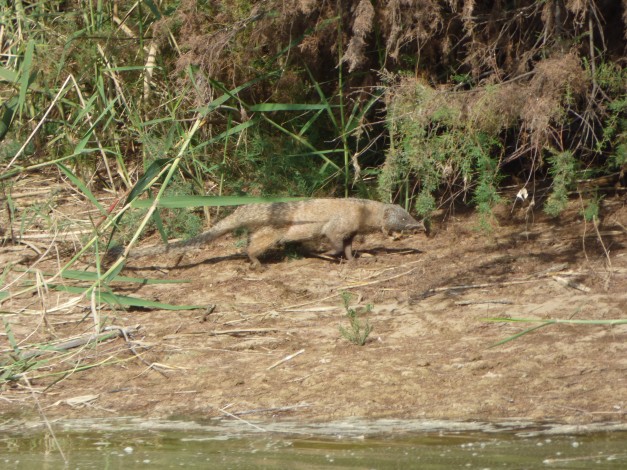
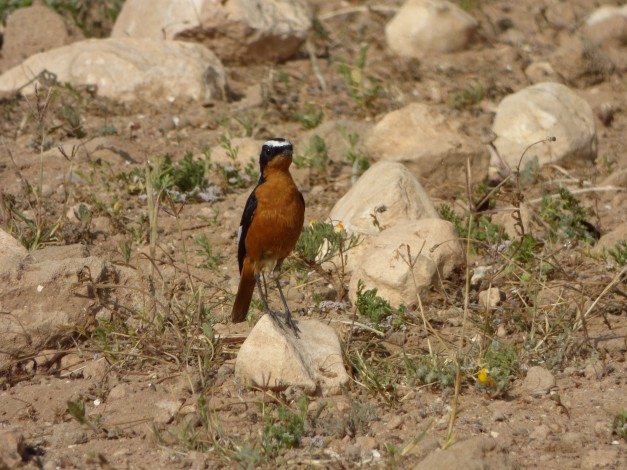
Happy after this really celebrated bird, we kept enjoying the good general birding around, this time in the way of some Laughing Doves, Little Egret, Moorhens and obliging European Serins. In the way to the minibus a song came out from the tamarisks. We moved slowly in the area until we found a good angle inside the bush and everybody in the group had wonderful views on the Western Olivaceous (Isabelline) Warbler. We had a pair of other birds singing before in the sames pot, but always deep inside the vegetation so we could not have a good view. The bird kept singing for about 1 minute so everybody had good views in the scope. After that the bird moved to the left in the tamarisks, with a series of good but brief views as the bird got inside the vegetation at the same time of catching insects.
Happy with this nice views we just headed to our accommodation for lunch. In the way, we anyway had a stop as a distant Western Orphean Warbler showes up far away in a palm tree. We had the bird in the scope but unfortunably not everybody had proper views on the bird. In this same spot we enjoyed European Stonechats, Crested Larks, Corn Buntings and up to 5 Willow Warblers lining on a fence!
A nice lunch and a refreshing drink gave us new energies to go on with the afternoon. Started to move back to Marrakech but before had a short stop in a different spot of the river. This is actually a roosting place for Glossy Ibises. A flock of about 60 were in the place this time. We scanned around for some minutes but got few. About to leave when the call of a Moustached Warbler came from down the reeds! We waited for long, waiting for something to happen. Suddenly, a bird came flew a pair of metres but inmediatly got again down. Still, enough to confirm that it was a Moustached! We waited for several minutes but nothing happened. We were close to leave when the bird appeared low in the reeds, at the other side of the pond and showed well for about 7 seconds! Unfortunately most of the group was far away so only a pair of tour participants got the bird. After that we waited some more time, but the bird never showed up.
We just arrived to Marrakech for lunch after a rainy transfer by motorway.
Day 4. This day we explored a number of spots in our way to Ouarzazate. Leaving Marrakech we did a first stop in a small gorge where to scan for some birds. In the way, Black Wheatear, Thekla Lark and Short-toed Snake Eagle were all seen witht the eagle having a sun bath in the morning sun. It was clear that some migration was going on since a pair of flocks of Black Kites were circling in the sky when arrived to the cliff. Here we scan for the top of the cliffs resulting in excellent views on 1 Lanner Falcon flying alongside 2 Eurasian Kestrels. This was an excellent comparision on size and structure between both species that all tour participants apreciated.
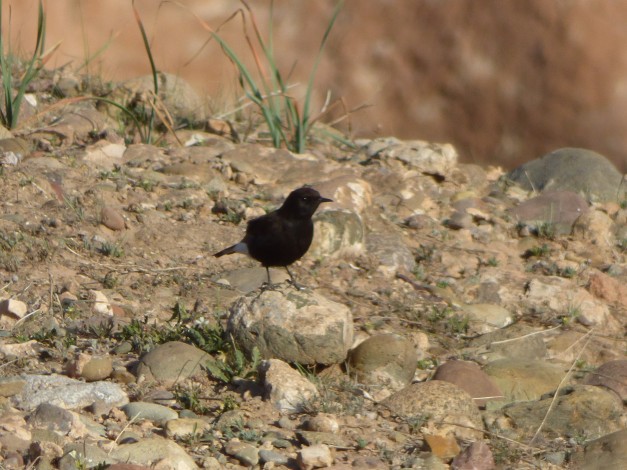
From the top the of cliff we were overlooking a small stream so again a good chance for some general birding. Both Grey Heron and Little Egret were fishing along the bank and a proper scanning produced 2 Wood Sandpipers and some Little Ringed Plovers. A flock of 8+ Common Rock Sparrows flew off the cliff and tipically stop on a wire in a nice but short action. Black Wheatears were really close and 2 Red-rumped Swallows also showed really well.
Back to the main road we were stopped by a Booted Eagle (light form) and 2 European Bee-eaters while Spanish Sparrows, European Serins and Eurasian Hoopoes were active all around. We did a coffee stop and it was a really productive one since we had no less than 11 Black Kites in really close views along with 1 Marsh Harrier and 2 Common Swifts passin over! Just at the moment to get inside the car, 2 Black Storks joined the thermal were most of the raptors were circling, allowing really good looks!
Our second stop of the morning was a bit less productive since we only had European Stonechats, Crested Larks, Sardinian Warblers, Serins and Corn Buntings. In fact we were arriving a bit late to the location but our delay was having a good explanation in the way of 1 Barbary Partridge really close to the van in the outskirts of Marrakech catching a wonderful morning light and 1 Great Spotted Cuckoo crossing the road right in front of the minibus! Unfortunably only some of the tour participants enjoyed this bird…
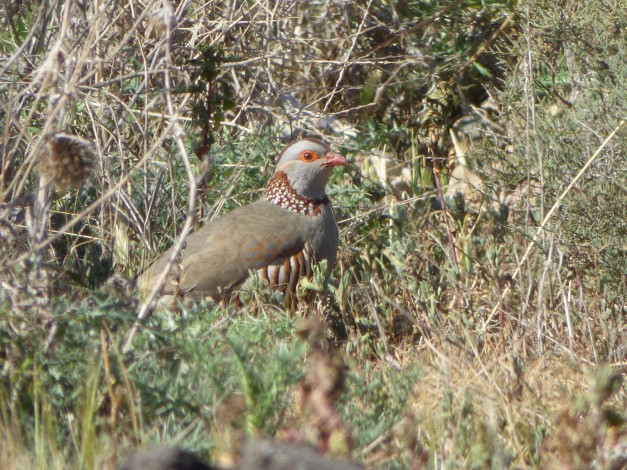
We faced to Marrakech. No traffic in the road so we did some miles before stopping and enjoying a good lunch with wonderful views on the lower Atlas mountains. Once back to the road, our next stop was to explore the highest part of the Atlas. When going to Oukaïmeden we were missing Alpine Choughs due to the unexpected high temperatures. Now we were stopping to check for them. But never found them! Instead we got 2 Red-billed Choughs chasing 1 Long-legged Buzzard along the valley. The raptor went to look for shelter in the cliffs and we were surprised to see that the bird was actually landing on its nest! We had good views on the Long-legged Buzzards by the scope. We scanned for Alpine Chough. But nothing. 1 Common Raven was noted before coming back to the minibus.
Our last stop of the day, already around Ouarzazate was to explore a small oasis with some olive and almond trees and big tamarisks. A really good spot for migratory birds. Here we enjoyed the firsts Woodchat Shrikes of the trips and ruff views on 1 Grasshoper Warbler skulking on the grass…1 Common Whitethroat showed up but nobody really connected with that bird out of me. Few birds in this spot. A final scan was done in the desertic slopes around, producing the firsts White-crowned Black Wheatears of the trip. Suddenly, a bird was moving by the road and it turned out in being 1 Desert Lark gentlenly walking by the tarmac. Nice views!
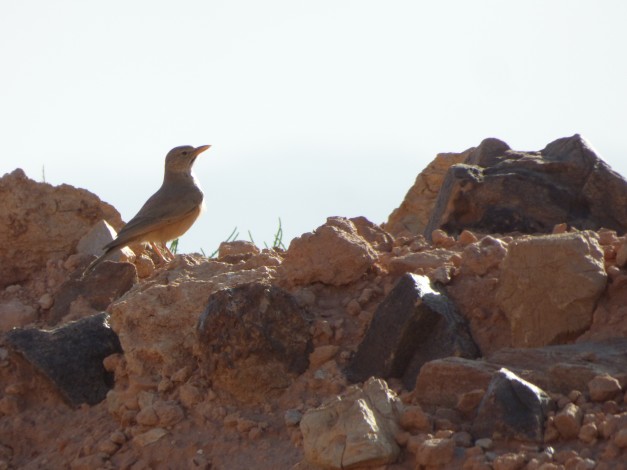
That was the day. After few miles left we arrived to Ouarzazate for a nice dinner and a deserved rest time!
Day 5. Early morning start to explore the dump inmediatly South of Ouarzazate. The dump was built to prevent big affluences of water in the lower Draa and has become one of the most important inland wetlands in Southern Morocco. A short walk is required to reach the shore. During the walk we had several good views on Maghreb Larks but also Woodchat Shrikes. Spectacle, Sedge & Subalpine Warblers were all seen. Walking in the sandy and bushy area (it is huge project to replant tamarisks) we got a Black Stork taking off from few metres in front of us! The bird flew to look for a new place where to land and rest a bit in its migratory journey.
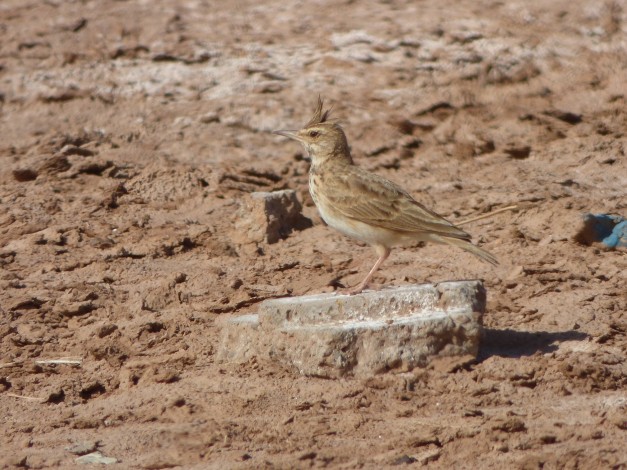
A small stream comes down to the dump. Along the shores we had good views on Little Ringed Plovers but also 2 Little Stints and several Iberian Yellow Wagtails. Flocks of Greater Short-toed Larks were passing in low flight, moving North. As we arrived close to the water, we got more and more wagtails, including some White Wagtails and the first Meadow Pipit of the trip.
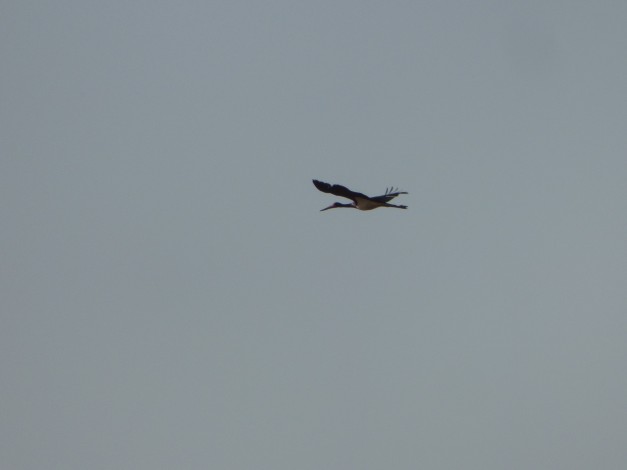
We finally got to the water. Some Northern Shovelers were feeding on the shore along with a pair of Eurasian Teals. Deep in the vegetation there were some Red-knobbed Coots feeding in the vegetation. 2 Black-winged Stilts and 1 Greenshank were also noted. But we were not having great views on the birds (the coots are always a good target in this trip) because of the dense vegetation inside the water so we decided to try a second area of the dump, hopefully producing better views.
In the way back to the minibus we got 2 Black-eared Wheatear, 2 Desert Wheatears and 1 Northern Weathear while small flocks of Black Kites were circling up on its way back to Europe. The morning light also helped in having really good looks on 2 Wood Sandpipers in the shore of the stream and better views on Maghreb Larks.
Once in the car we drove some miles until a our next attemp to approach the shore. The drive down, crossing a steppe land was really productive with a family of White-crowned Black Wheatears feeding its chicks, 2 Desert Larks, Desert Wheatears and lovely views on 1 Tawny Pipit. Once beside the lake we enjoyed great views on 1 Osprey flying above the dump. Ruddy Shelducks were also shoring nicely. Here we also had distant views on Great Crested Grebes and Grey Herons while hundreds of White Storks were gathering in huge flocks, circling up in the sky as they were ready to cross the Atlas! A distant flock of Black-winged Stilts were seeing flying, joined by 1 Black-tailed Godwit. 1 Marsh Harrier were also overflying the reedbeds. Just in the limit of the vegetation, some waterfowl was feeding. We had Eurasian Teals but also proper looks on Red-knobbed Coots showing the typical shape of the shield. But the very best bird of the area were 3 Marbled Teals showing in lovely light and moving fast in the open water to get shelter in the aquatical vegetation. Everybody in the group had excellent views on the birds and it was one of the most celebrated birds of the tour!
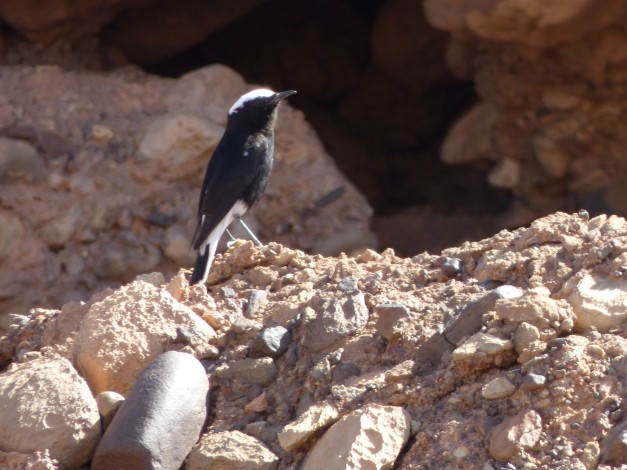
After such a wonderful and rather unexpected finding we just headed back to the main road for a good lunch. Refreshed by the shade and the food, our transfer to Boulmane du Dades happened fast and comfortably. Once checked in our hotel we still had some time to rest before going for some exploring of the huge steppes inmediatly South and East of Boulmane.
And we had a pair of excellent hours there! Just arrived there we had a flock of tens of White Wagtails moving in the area along with some Meadow Pipits and Northern Wheatears. A further scanning produced the firsts Red-rumped Wheatears of the tour with beautiful views. We did a stop to enjoy Temminck’s Larks, being as numerous as I never saw before! They were everywhere. We also had good numbers of Fat Sand Rats moving around.
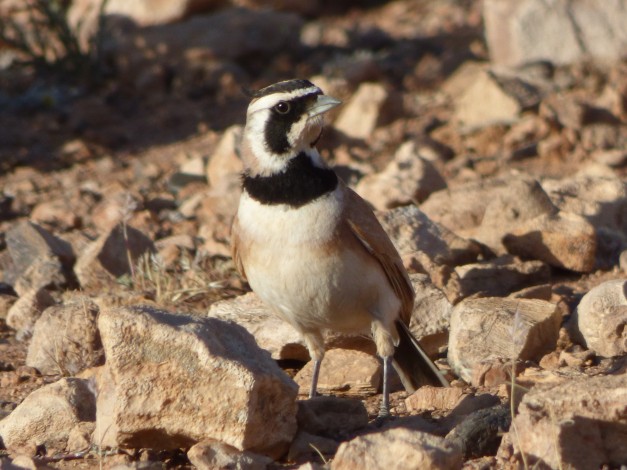
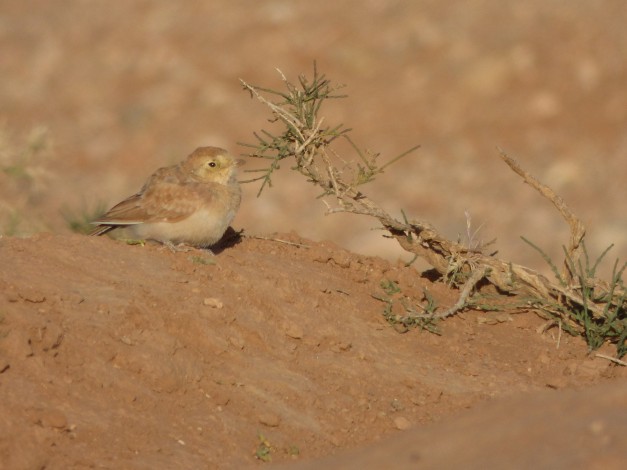
Our last stop was to explore a small corner. Less than minute after arriving we were having good views on Cream-coloured Coursers. We counted 11 of them running (coursing) and delighting our group with wonderful views. A further scanning around also produced good views on 1 Thick-billed Lark moving among the vegetation but our attention came fastly to one bird flying to us that turned out to be 1 Greater Hoopoe Lark! So we were having at the same time Coursers, Thick-billed Lark and Greater Hoopoe Lark!! What a momment of the trip. In fact, Temminck’s Larks were also around…

We ended the day with great views on both Greater Hoopoe Lark and Cream-coloured Coursers just by the minibus, complemented with views with the scope! When driving back to our accommodation, a flock of 11 Stone Curlews were a final bonus for the evening!!

Day 6. This morning we enjoy a great breakfast in our accommodation before going back to the huge steppe area around. Our first stop is a stream with some ponds of water so likely to attrack Sandgrouses to drink water. In our way to the spot we had several Desert and Red-rumped Wheatears along the road as well as some Temminck’s Larks. Just arriving, we had a Booted Eagle in the opposite bank of the the stream, barely 50 metres away from the minibus! A short walk around the area fastly produced first sights on Trumpeter Finches moving around the broken terrain. We also had European Serins, Greenfinches and Goldfinches moving all around. Thekla Larks were really showy as well. But no Sandgrouses… A harder scanning of the area produced 1 Woodchat Shrike, Common Bulbuls and 1 Corn Bunting and suddenly we got a far calling in the sky and some seconds later we got 4 Black-bellied Sandgrouses flying around to stop in a distant point. Some of the tour participants got distant views in the scope but unfortunably the flock flew out before everybody could enjoy them… We still wait a good while, scanning for migratory birds but getting little. 2 Black-bellied Sandgrouses flew over us, allowing really good views on them. This year the area looked like having few Sandgrouses so we went to a different spot.

A short drive in the steppes allowed us to see more Temmink’s Larks (everywhere this year) along with Greater Hoopoe Larks singing and displaying around in a wonderful way! When enjoying the Larks we were distracted by a distant flock of birds flying that it turned out to be 20+ Cream-coloured Coursers!! Kept scanning around, now in a small farm land. The place was plenty of Northern Wheatears in migration North, joined by Yellow Wagtails but also 1 Woodchat Shrike. 1 Desert Grey Shrike was also a nice adding to our list!
We then went a bit further. A crag in the area is a good corner for som especies and we did well in coming to check that small area! Just arrived with the minibus had close, really close views on Cream-coloured Courser as 6 birds were moving alongside our van! Suddenly, a bird crossed the dart road, stopping 60 metres away in the slope. It turned out to be a Thick-billed Lark! So we stopped and jumped out to try to improve the views we got the day before. Hard work as we were all the time distracted by the Coursers moving beside us. We gathered and went closer to the lark. A close approximation allowed us to have wonderful views on the bird (a female) while being concentrated in killing a big cicade! The bird was simply 20 metres away from us in really good light!
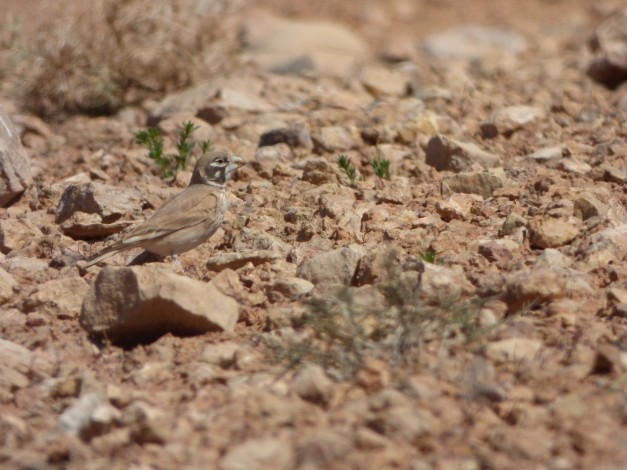
Very happy after such a nice views we just moved on to explore that crag but again something took our attention as a close bird was singing behind us. We all turned back and a absolutely amazing Maghreb Wheatear appeared in front of us, barely 30 metres away! We all had really good views on the bird despite it was highly mobile in the slope. This was one of the most celebrated birds in the trip!!!
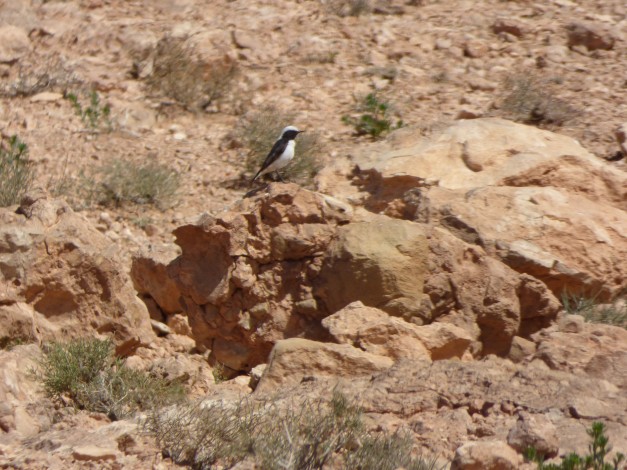
Amazed after all the good birds around we jsut went down the crag. The place is hosting a pair of Pharaon Eagle Owl and soon we were all having nice views on one roosting deep inside a hollow. All the group was delighted with this amazing views and all the good birds in such short time! And we were just chating about when a spectacular Lanner Falcon appeared up in the sky, flying low over the crag with incredible good light so everybody could enjoy the magnificient bird. After some circling, the bird just started calling in a soft way and disappeared fast to one side of the crag. Absolutely stunning!!
Happy after such a productive morning we just came back to our accommodation for a good lunch and some rest before doing some afternoon birding. Before dinner we just went out for some fast birding. Visiting some cliffs we just had good views on both Blue Rock Thrush and Black Wheatear while Trumpeter Finches were moving around. A bit beyond, a last stop allowed us to enjoy 1 Black Redstart as well as two wonferul Barbary Falcons flying around, diving in an incredible manner and we also had good views on the cliff.
The sun was not specially high any more so it was time to go back to the accommodation, enjoy our dinner and have some good rest!
Day 7. Batteries recharged after a good rest, went down for breakfast. This day we were moving from Boulmane du Dades to Merzouga so it was time for some stops in the way while approaching the desert. It was again a sunny day but colder than expected (contrastin with the higher than average temperatures in the Northern slope).
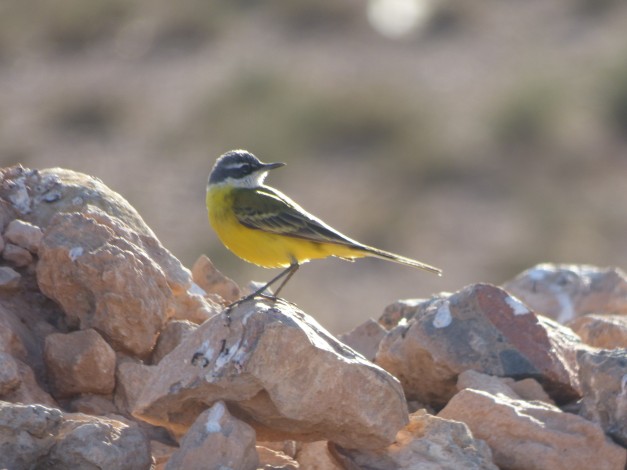
Before doing some kilometers we just did a stop in one of these corners attracting many migratory birds. Here we got a numerous flock of White Wagtails and Greater Short-toed Larks, being joined by 2 Iberian Yellow Wagtails, several Meadow Pitpits and Northern Wheatears and 1 British Yellow Wagtail. Desert & Red-rumped Wheatears were also noted. A Little Owl sitting on the top of a pile of stones was a nice adding to the day list!
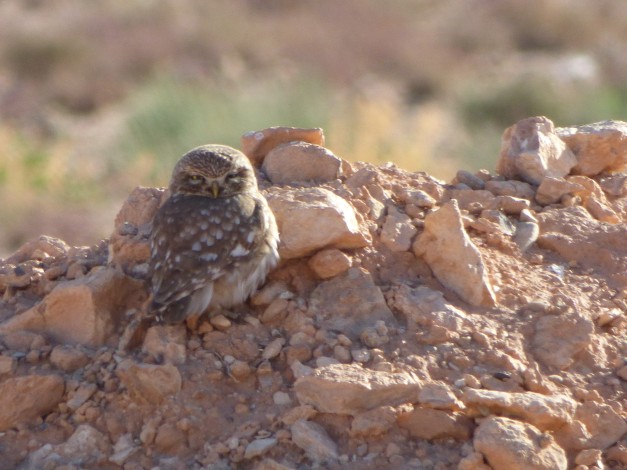
We then went for a 90 minutes transfer to stop in a desertic spot. This is a well known place for Scrub Warbler so we parked the minibus and started scan around. The area was having some hundreds of Greater Short-toed Larks feeding on the ground and moving in a endless motion around the scrubs. 2 Tawny Pipits were also moving along with them. Woodchat Shrike and Northern Wheatears were also noted. Flocks of swallows were passing by, and along with the Barn Swallows we did enjoy the firsts Sand Martins of the trip. We just walked a bit around, covering as much territory as possible. Spectacled Warblers looked like common, with some males even singing and showing up in the top of a bush for a while.
Herds of Dromedaires were grazing in the area, being a really nice setting of low scrubland in the desertic plain with tall mountains as a remarkable frame. Our walk was being not that productive as it was no trace of Scrub Warbler so we decided to go back to the minibus when suddenly something moved in front of. A bird skulking down with a long tail: Fulvous Babbler! Fastly we were all in the bird and we had wonderful views not in one but in 5 Fulvous Babblers moving on the ground and even going up in a bush to offer us a remarkable view of the birds!

We came happy to the minibus so we decided to do a last stop before going for lunch. The stop produced the same birds in the last one (out of the Babbler) but just when we were coming we got 2 Bar-tailed Larks walking around us. In our way back tot the van, a male Thick-billed Lark flew in front of us to stop some 100 metres away!
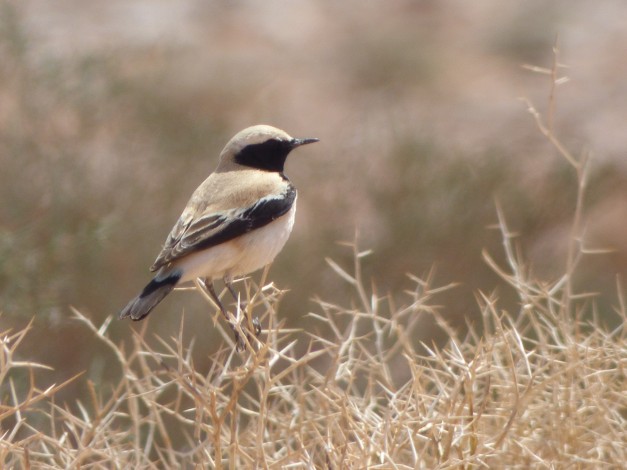
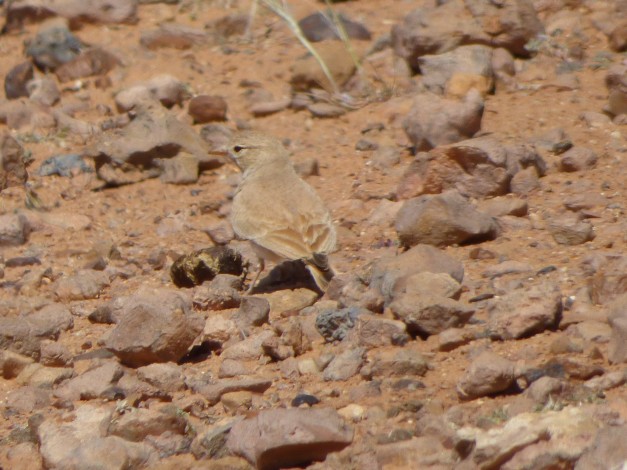
After lunch we just kept our way to Merzouga, to end the day with some birding in the impressive lake in the middle of the desert. Here, the afternoon light gives the lake in the dunes a amazing reflection of a bizarre mix of Flamingoes, Stilts and sand dunes…
The lake was just as great as always. About 400 Greater Flamingoes were roosting in the deeper part of the lake. All around the shore, hundreds of Ruddy Shelduck and good numbers of Black-winged Stilts were feeding. Along with them small numbers of Kentish and Little Ringed Plovers but also Wood & Green Sandpipers, Greenshanks as well as 2 Little Stints and 1 Common Snipe.
A big flock of Eurasian Coots were feeding and we were able to pick up 3 Red-knobbed Coots among them. A bit beyond a flock of 13 Ferruginous Ducks were diving in search of food, with a closer flock of Common Pochards providing good views. Midday between them, an unexpected male of Tufted Duck was a good adding to our lists. 2-3 Gull-billed Terns were flying above the lake. Far in the distance, a flock of Pied Avocets were feeding along with Stilts.
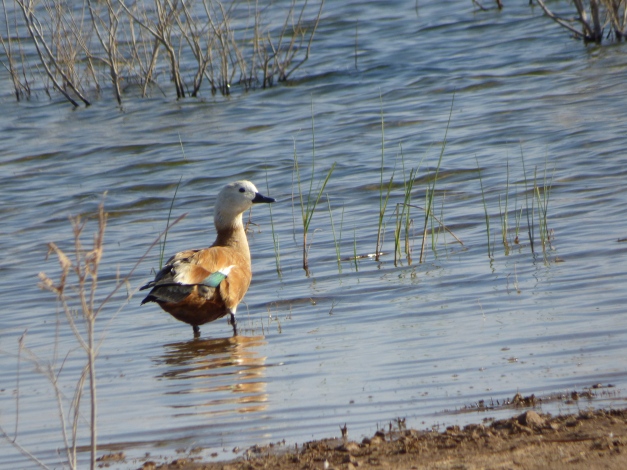
We just moved a bit in the shore to have a change of angle and keep scanning. As moving in the sparse bushland around we got good views on Subalpine & Willow Warblers. Scanning the lake we got a good flock of 15+ Marbled Teals, moving in the opposite bank. Many ducks were concentrated there including Shovelers but also Eurasian Teals, Northern Pintails and 1 Garganey that unfortunately nobody else saw out of me.
Great Crested Grebes were also noted all around and big flocks of White Storks and Barn Swallows started to gather around to spend the night. It was momment for us leave and go to our accommodation for a wonderful dinner and some good rest!

Day 8. Our day in the desert was this year especially wonderful. Ours first stop that day was to enjoy some close views on Desert Sparrows deep in the desert. A party of 10 of them were feeding, providing with excellent views on both males and lovely females showing that orangish coloration so typical in true desert birds.

Our second stop was to visit a pond where Sandgrouses come to drink water from all the area around. The “pond” is few more than a 10 metres long streght of water, few centimetres long. In the way we had firsts views on Brown-necked Ravens. Once in the place we had to wait a bit. Some flocks of Sandgrouses were flying around. A small flock of 4 Spotted Sandgrouses came on the ground and walked a bit but still far away from the water. More flocks were arriving from the desert around. We counted about 50 Spotted Sandgrouses and 16 Crowned Sandgrouses in different flocks landing about 300 metres away from the water.
More minutes of waiting with little action. Suddenly a male Spotted Sandgrouse arrives flying until the water, drinks and inmediatly goes away. One minute later 3 more Spotteds come to drink water. Then 5 more. And suddenly tens of them arrive to the pond in a mess of calls powerful wingbeats. Both Crowned & Spotted offer good views to everybody in the crew and after few minutes they all fly away!
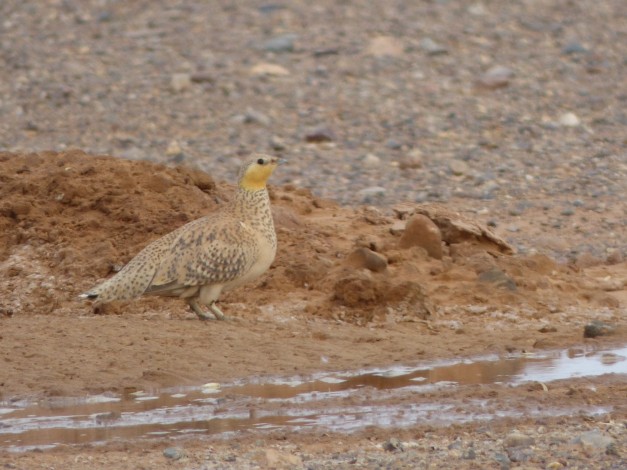
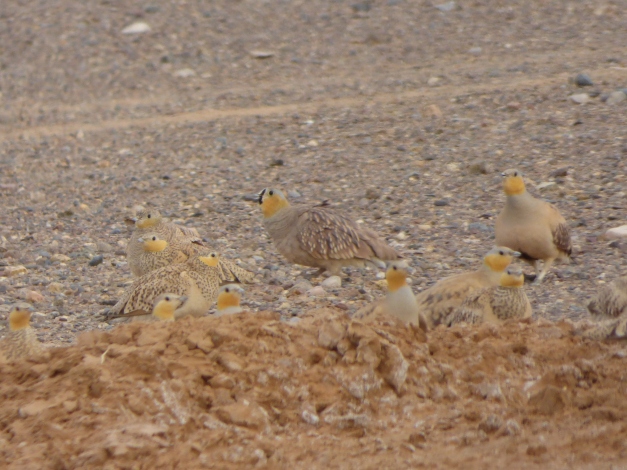
Around the pond we only have 4 Crowneds and 3 Spotteds, far away, still waiting for drink water. Suddenly, a Lanner Falcon appears in the sky chasing a Feral Pigeon. The bird offers brief views and it is interesting that it flies over all Sandgrouses but see none of them!
Our next stop is to visit a ringing station of the Catalan Bird Assotiation (Institut Català d’Ornitologia). When arrive we are lucky enough to the guys being ringing in that momment. And we are truly lucky as they are ringing only one bird, 1 Iberian Chiffchaff that was already captured some days ago!!! Birds in the area can stay several days feeding as they have to accumulate enough grease to finish the migration back to the nesting places. They area likely to need a good recovery since this area is normally the first stop for them after crossing the Sahara desert!
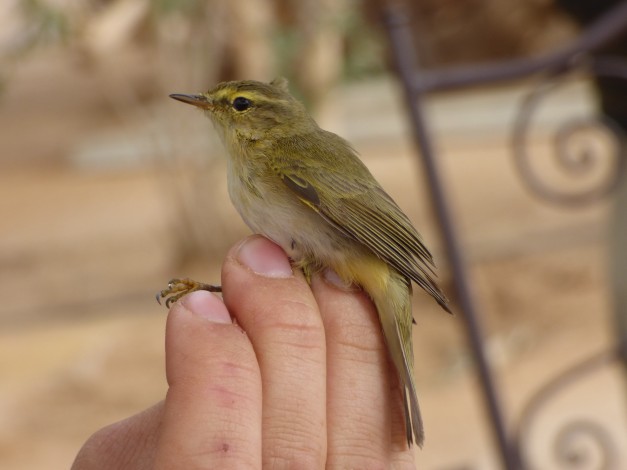
It is always nice to have such a close views in taxa which is normally difficult to identify in the field (virtually not possible as long the bird doesn’t call…)
We also did a short walk around the area. The bush land around the ringing station produced great views on common migratory species such as Common Redstart, Woodchat Shrike, Western Bonelli’s Warbler, Willow Warbler, Subalpine Warbler as well as 1 female Bluethroat. We also relocated the Iberian Chiffchaff feeding along with 1 Western Bonelli’s Warbler, resultin a nice comparision on structure and sizes.
Happy after such a good encounteer we kept moving on, this time to visit a roosting place of Egyptian Nightjars. When arriving to the area our local guide was already waiting for us and it took short to contact with 2 different Egyptian Nightjars roosting in the wady!
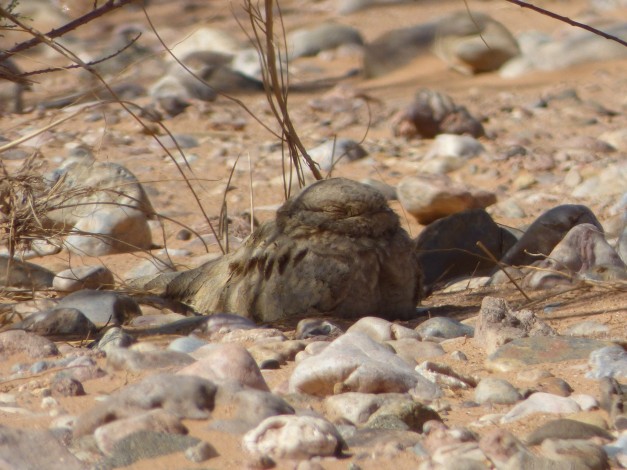
Nearby the Nightjars we were having a African Desert Warbler when passing by with the car. So we just went to have a look. Subalpine & Spectacled Warblers were around and we also had Bar-tailed Larks moving around along with Common & Pallid Swifts, but no signal of the African Desert Warbler. Finally we decided to try somewhere else and we were lucky enough to have the bird even before getting out of the car! This time the small warbler showed really well and everybody had excellent views on the bird!!!
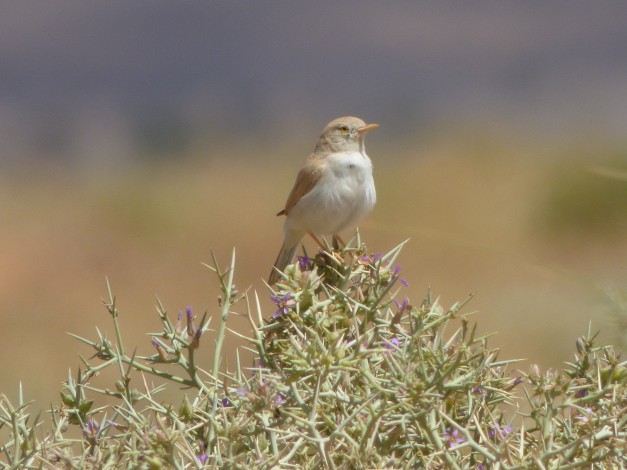
After this we just drove to Rissani for lunch and some rest but in the way we had to do a pair of stops: first for a distant flock of Blue-cheeked Bee-eaters that finally produced excellent views and the second in a lovely male Seebohm’s Wheatear by the road!

The last stop in this incredible day was to look for Saharan Scrub Warbler. This bird can be really tricky, as everybody that has birdwatch in Maghreb probably has noticed. We did a good scanning in one of the territories and got some birds in migration including Hoopoe, Greater Short-toed Larks, Common Redstart and Subalpine Warbler. Also a pair of Spectacled Warbler and Desert Lark were noted. After the long scouting we really were about to abandon when suddenly a Saharan Scrub Warbler flew under our feet and moved to right. The bird fastly stop on the ground, tailed up, showing really well. Part of the tour participants had the bird moving but other people had only the sense of motion…The bird was still moving in the scrubs and we were really trying to keep track on it! Some more brief views, on the ground or flying (then showing the long, rounded, white tipped tail as well as the barred back, rump and tail) and the bird literally disappeared in the scrubs…We searched and searched for it and we were still capable to relocate it but we were absolutely uncapable to do any tour participant reconnect with it… At the end, some people had good views but others only ruff views on this really, really skulking bird!
After this we headed back to out accommodation for some rest!
Day 9. This morning we went back to the lake of Merzouga for some birding. One of the corners of the lake provides excellent habitat for a number of scarce migratory species. In our way we got a female Montagu’s Harrier doing its way North. Also in the way we enjoyed excellent views on Brown-necked Ravens while moving in the desert. Once arrived we did a short walk around. The shore of lake here is a gentle prairie of grass with scattered tamarisks and small ponds and channels. An excellent corner to look for scarcer birds.
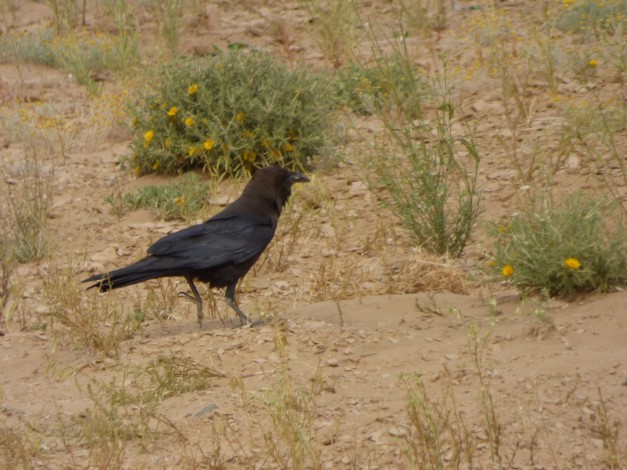
Many Iberian Yellow Wagtails were around. The riparian vegetation was full of warblers, mainly Sedge Warblers bul we also got several Subalpine Warblers (inornata and cantillans races, mainly), Willow Warblers and 2 Eurasian Reed Warblers. 1 Common Redstart and 1 skulking Bluethroat were also noted. 2 Red-throated Pipits flew over us, but nobody could connect with the birds in the sky. Other good birds around included Meadow Pipits, Red-rumped Swallows and Maghreb Larks.
We then went to spend some time in one of the few locations for Eastern Olivaceous Warbler around Merzouga. We went in a short walk around an area with tamarisks trees and other bush. This year the area was virtually empty of the birds, normally singing around at the end of March. We neither had many migratory birds, as usual. A scan in the area produced some Subalpine Warblers along with Western Bonelli’s & Willow Warblers. We spent some time here scanning the trees and got brief views on both Garden & Melodious Warblers up in the canopies. A single Eastern Olivaceous Warbler was found singing and, after a long search, we had good but brief views on the bird!
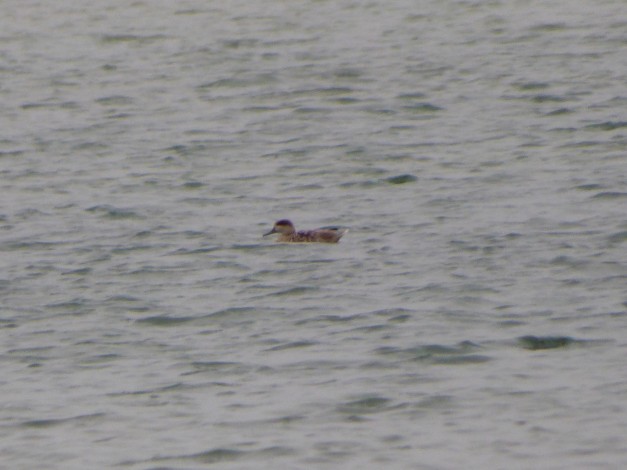
After this we came back for lunch in our accommodation and, after lunch, we went to spend some more time in the lake. Light and temperature were really pleasant for birding when we approach the water and we enjoyed excellent views on 30+ Marbled Teals. A mixed flock of ducks concentrated our attention as it was having Northern Shovelers, Eurasian Teals and something else…A proper scanning revealed a female Blue-winged Teal (!!!!) and, further on, a hybrid of Cinnamon Teal x Northern Shoveler!! An amazing to see this North American vagrants in the Saharan desert!!!
This was one of the best momments of the tour! We got good views on the ducks, paying special attention to the mix of characters of the hybrid…Unfortunately we were a bit far away to take any Picture but we were informed that the birds had been there for some weeks.
After enjoying really much these ducks we kept scanning around and got some good birds in the way of a juvenile Eurasian Spoonbill and proper looks in a drake Garganey.
Happy after this nice afternoon we came to the hotel for our last dinner in the desert before going back to Marrakech.
Day 10. Final transfer from the desert to Marrakech. This is a typical driving day. All the typical that can be with a mid way stop to enjoy Pharaon Eagle Owl but also close views on Desert Lark and Desert Wheatear.
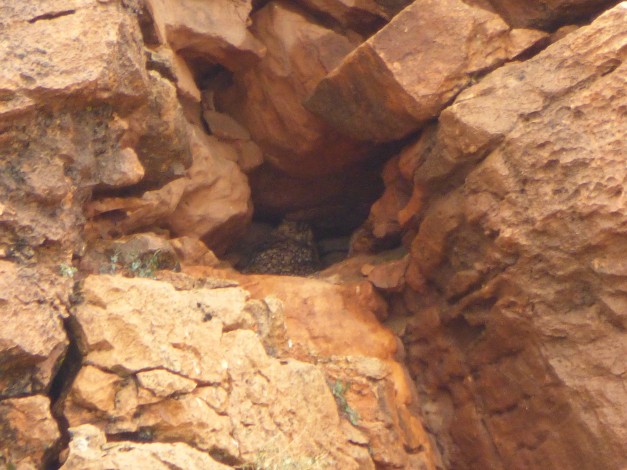
The way back was a bit longer than expected due to some rain in the desert and along the Southern slope of the Atlas. Many small “wadys” (dry rivers) were actually having water and the road was having several water courses crossing it…We finally arrived to Marrakech for a nice dinner and a last surprise in the way of 1 North African Tawny Owl calling in the gardens of our accommodation. Definately a good way to end our tour.
Looking forward our 2020 issue. Do you want to join?
